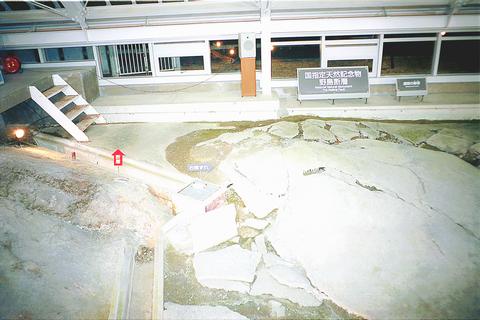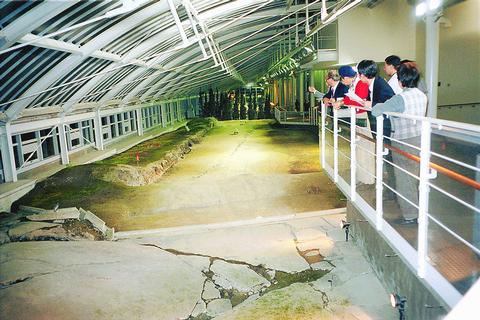Residents of Kobe, Japan, have been sending out "Kobe 2001 -- Thanks and Welcome" postcards to invite people from around the world to this reborn city, nearly five years after it was seriously damaged by a devastating earthquake in January 1995.
At Phoenix Plaza (

PHOTO: CHIU YU-TZU, TAIPEI TIMES
The Kobe earthquake claimed the lives of at least 6,400 people from Kobe City and the surrounding region. Tens of thousands lost their homes. The natural disaster caused losses to the Japanese economy estimated to exceed US$100 billion.

PHOTO: CHIU YU-TZU, TAIPEI TIMES
Almost six years after the disaster, however, the image of the devastated Kobe presented in the exhibition is totally different from the reality outside the museum. The modern buildings and quick tempo of city life cause visitors to marvel that post-disaster reconstruction has been carried out so quickly and effectively.
Volunteers at Phoenix Plaza are helping residents to draw postcards or write invitation cards. The festival, called "Kobe 21st Century Restoration Commemorative Project," is scheduled to start on Jan. 17, exactly six years after the earthquake.

PHOTO: CHIU YU-TZU, TAIPEI TIMES
The volunteers said that it was time for the residents of Kobe to show their appreciation to people everywhere who assisted them after the earthquake.

CARDS COURTESY OF CITY OF KOBE
Museum on Awaji Island
A joyful rebirth seems to have occurred after a persistent fight against despair. The earthquake, nevertheless, remains a poignant memory for most of those who experienced it.
Death and destruction were not the only legacies of what has become known as the Great Hanshin-Awaji Earthquake Disaster (
Before the earthquake, which jolted the Kinki (
During the quake, officially known as the Southern Hyogo earthquake (
In order to preserve the dramatic changes to the topography on Awaji Island caused by the tremor, the Japanese transformed the site, located in the Hokudan-cho earthquake Memorial Park, into the Nojima Fault Preservation Museum.
About 140m of the newly exposed fault line have been preserved and are displayed at the museum's site. The museum has been designated a state-owned property.
"We built the museum as a reminder, which would be helpful to the fields of both scientific research and disaster prevention work. So far, the number of visitors has exceeded 4.6 million," said Hatsuo Hirata (
Visitors can also see explanatory displays, including large panels, models and a miniature theater.
"Japanese scientists have known that the topography of the center of the Kinki area is complex. It includes low lying areas such as Lake Bewa, Osaka Bay and the Kyoto and Nara basins, as well as high mountains such as the Hira, Ikoma and Rokko ranges," said Tomoko Kawayoshi (
Kawayoshi said although the Kobe earthquake occurred in the region, where a complex system of active faults had been mapped, the discovery of the missing part of the Nojima Fault still taught people a lesson.
"No matter what, the serious damage caused by the Kobe earthquake has made Japanese people take disaster prevention more seriously. That's why we have this museum," Kawayoshi said.
In the museum, visitors can easily observe the displacement of the fault, which made violent movements, causing the dislocation of hedges and the destruction of roads. A trench provides a good opportunity for visitors to see the actual profile of the fault close-up. It shows a section of strata, exposed down to 2.5m below the earth's surface.
A house, standing right on the fault line, is also preserved and open to the public. Its interior is arranged to show the results of the Kobe earthquake, leaving future generations to understand what occurred. A kitchen damaged by the earthquake is reproduced based on oral evidence.
"The house standing on the fault line was not torn apart during the disaster. The owners of the house stayed in the house for more than three years after the quake," Kawayoshi said.
Kawayoshi said that the case inspired Japanese engineers to design stronger quake-resistant buildings and call for the tightening of building regulations.
Currently, the museum is maintained and operated by 75 staff from several groups in Hokudan Town.
"We hope to keep the evidence to remind people of the importance of disaster prevention," director Hirata said.
Outside the museum, a pyramid-shaped "memorial for the repose of souls" faces the sunset. Hirata said that it was established as a symbol not only for the repose of lost souls. "It also prays for the surviving inhabitants here," Hirata said.
Shaking Table
For Japanese scientists, a more forward-looking, optimistic way to address the specter of the earthquake damage was to improve construction technology.
The destruction of 690,000 buildings, damaged completely or partially during the Kobe earthquake, led scientists to believe that they had a poor understanding of ground motion characteristics.
One message that came through from an engineering perspective was that the engineering profession has much to learn about the effects of massive stress on structures.
Although Japanese scientists have been capable of conducting computer simulations of the shaking motion of houses during earthquakes, the Kobe earthquake convinced them that it was necessary to build a large shaking table (震動平台) to conduct three-dimensional full-scale earthquake testing.
Shaking tables are used by scientists around the world to simulate and test the effects of seismic activity on buildings and other structures.
"In order to improve the capacity of buildings to resist dramatic shaking during earthquakes, we persuaded the government to spend money on building the shaking table for further studies," said Tsuneo Katayama (片山恆雄), director general of the Japan National Research Institute for Earth Science and Disaster Prevention Science and Technology Agency.
Construction of the table, located in Miki City, to the north of Kobe City, started in 1999. It is scheduled to be complete in 2005, a decade after the Kobe earthquake. By then, Japan will have spent at least ?40 billion (US$353 million) on it. The foundations of what will be the world's largest shaking table, 20m long by 15m wide, are about thirty percent complete.
The shaking table will make it possible to test real buildings until they collapse. Such experiments will help engineers to improve earthquake-resistant designs.
"In the future, we will put a four-storey building, which weighs about 1200 tonnes, on the shaking table to test its performance during different degrees of earthquakes," Katayama said.
Katayama said that the collapse of buildings and of highway viaducts during the 1995 Kobe earthquake, the 1996 Northridge earthquake in the US, the 1999 921 earthquake in Taiwan and others, showed the vulnerability of modern cities and infrastructures.
Katayama said that Japan welcomed scientists and engineers from all over the world to visit to carry out full-scale experiments.
"Although experiments cost a lot, their contribution to the prevention of unnecessary loss of life and property will be invaluable," Katayama said.

On April 26, The Lancet published a letter from two doctors at Taichung-based China Medical University Hospital (CMUH) warning that “Taiwan’s Health Care System is on the Brink of Collapse.” The authors said that “Years of policy inaction and mismanagement of resources have led to the National Health Insurance system operating under unsustainable conditions.” The pushback was immediate. Errors in the paper were quickly identified and publicized, to discredit the authors (the hospital apologized). CNA reported that CMUH said the letter described Taiwan in 2021 as having 62 nurses per 10,000 people, when the correct number was 78 nurses per 10,000

As we live longer, our risk of cognitive impairment is increasing. How can we delay the onset of symptoms? Do we have to give up every indulgence or can small changes make a difference? We asked neurologists for tips on how to keep our brains healthy for life. TAKE CARE OF YOUR HEALTH “All of the sensible things that apply to bodily health apply to brain health,” says Suzanne O’Sullivan, a consultant in neurology at the National Hospital for Neurology and Neurosurgery in London, and the author of The Age of Diagnosis. “When you’re 20, you can get away with absolute

May 5 to May 11 What started out as friction between Taiwanese students at Taichung First High School and a Japanese head cook escalated dramatically over the first two weeks of May 1927. It began on April 30 when the cook’s wife knew that lotus starch used in that night’s dinner had rat feces in it, but failed to inform staff until the meal was already prepared. The students believed that her silence was intentional, and filed a complaint. The school’s Japanese administrators sided with the cook’s family, dismissing the students as troublemakers and clamping down on their freedoms — with

As Donald Trump’s executive order in March led to the shuttering of Voice of America (VOA) — the global broadcaster whose roots date back to the fight against Nazi propaganda — he quickly attracted support from figures not used to aligning themselves with any US administration. Trump had ordered the US Agency for Global Media, the federal agency that funds VOA and other groups promoting independent journalism overseas, to be “eliminated to the maximum extent consistent with applicable law.” The decision suddenly halted programming in 49 languages to more than 425 million people. In Moscow, Margarita Simonyan, the hardline editor-in-chief of the